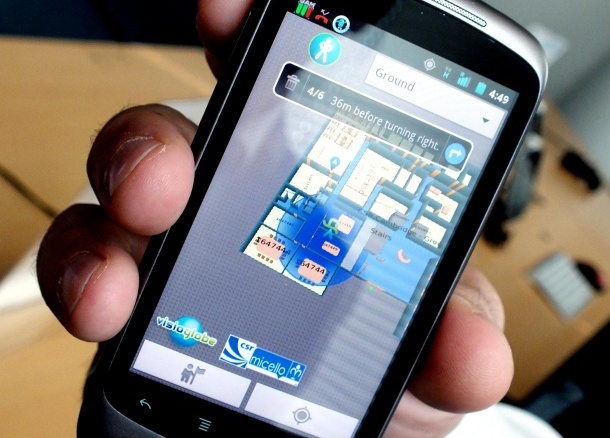Indoor navigation coming to a mobile near you soon

Chip designer Cambridge Silicon Radio has said it is talking to all the major mobile vendors about integrating indoor location technology into their smartphones.
The company told ZDNet UK it expects to see mobile products containing the technology required for accurate indoor location and navigation on the shelves by the end of 2013. However, Blake Bullock, product manager of the indoor location tech at CSR, would not be drawn on which manufacturers the company is talking to, confirming only that all the big handset makers are among them.

Cambridge Silicon Radio's SiRFStarV chip will let people find their way around large buildings. Credit: Ben Woods
By including the technology in mobile phones, consumers will be able to use location-based services within buildings as well as outdoors — functionality that is largely unavailable on the current generation of devices.
"Today, nearly every smartphone sold has GPS included as standard... When you look at the number of applications available on iOS and Android, it's mind-boggling: there are hundreds of thousands of applications and a significant number of these use location in some way, either fundamentally like mapping and navigation or to improve the service, such as in search. LBS [Location Based Services] are a daily experience," Bullock said on Thursday.
"The problem is as consumers come to love these services and the way they work with location, they get frustrated as they go indoors and find they don't work, or don't work as well as outdoors," he added.
Range of accuracy
The technology underpinning the indoor navigation features is CSR's SiRFStarV chip and SiRFusion software which, in its current form, is accurate to around 10 metres around 50 percent of the time. Bullock told ZDNet UK that in reality, it can already be accurate to about 5 metres but that CSR was erring on the side of caution with its claims.
To put the accuracy in perspective, it is the difference between knowing that the ZDNet Towers is a street in Southwark, London and knowing where the ZDNet UK desk is located on the fourth floor of a particular building in Southwark, and being able to navigate directly to it.
In order to track location, the system — unlike some competitors — does not rely on bespoke installation of new infrastructure and amalgamates signals from a range of inputs including Wi-Fi transmitters, Bluetooth Smart, GSM and GNSS (Global Navigation Satellite System).
"Location capability is underperforming today where it needs to be to meet the needs of the marketplace," Bullock said. "SiRFStarV is our latest generation in GPS chipsets, and really it's not fair to call it a GPS chip anymore, it's a GPS processor. It includes several technologies, including multiple GNSS so it can track GPS and Glonass satellites."
The system also has a MEMS Gateway, meaning it can accept input from MEM sensors found in smartphones, such as compasses, accelerometer, magnetometer, gyros and in some cases barometers to help keep track of people inside of buildings, Bullock said.
CSR's SiRFStarV system would allow a range of new features on smartphones, tablets, cameras, fitness and personal trainer devices, by helping users to, for example, find specific shops or products in a shopping centre, and help them meet up with friends or check in to location services — such as Facebook Places or Foursquare — in indoor locations, Bullock said. It also allows for specific venues, such as conference centres, shopping malls or theme parks to provide comprehensive indoor maps with walking directions.
Bullock also said it would provide new opportunities for targeted advertising, particularly as Google is focusing on indoor mapping and ads: it provides tools for uploading building blueprints to generate indoor maps, and is making ads and targeted coupons for indoor locations.
Navteq and Micello are also working to make indoor maps more widespread.